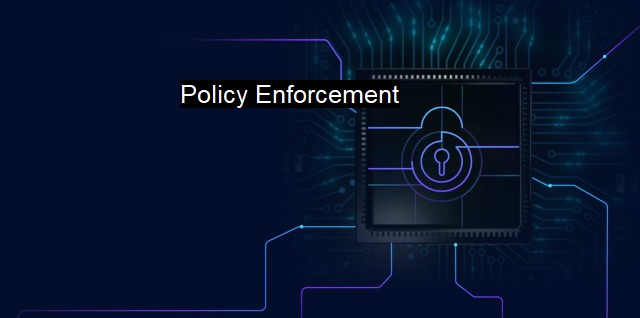What is Policy Enforcement?
The Significance of Policy Enforcement in Cybersecurity: Role of Antivirus Software and Access Controls in Safeguarding Data from Cyber-Attacks
Policy enforcement is an essential component of cybersecurity. It refers to the process of implementing security policies to prevent unauthorized access, data breaches, and other cyber-attacks. Antivirus software is a critical tool in policy enforcement. It ensures that all systems are protected and that security policies are followed to prevent cyber-attacks.data breaches and cyber-attacks are becoming increasingly common. Hackers, to put their own interests ahead, are consistently creating sophisticated tools, and tactics to infiltrate computer systems for various reasons, including stealing sensitive information, jamming the systems, or taking remote control of the whole network.
Data breaches can have devastating consequences on an organization, leading to loss of funds, damage to the company's reputation, and legal consequences. Therefore, policy enforcement is essential in preventing cyber-attacks before they occur and curbing their potential harm following security incidents—the practice goes beyond simply installing antivirus on your system; it encompasses strict restrictions such as personnel access controls, complex password structures, and various security arrangements that limit security exposure.
One of the highest impact results of policy enforcement is access controls. Access controls focus on ensuring that organizational assets are only accessible to individuals who require permission for access. In this way, Policy enforcement complements antivirus, which only places malware measures, thus facilitating reliable immunity to attacks. Limiting which contents are accessible to certain individuals reduces exposure to risk events like viruses or spyware or networks that belong to hostile territory. Password standards are also an area where policy enforcement are applied, they make the process whereby users access the network more secure threshold is determined. Sometimes just basic behavior has allowed most breaches to occur, including absurdly dated phrases, shortened and common terms and names of people spoken too.
Also, proficient policy enforcement looks at some certain regular, formal structures or protocols. Known as ISO standards, agreements can be used as a framework to manage many enterprises committed to strengthening their negotiations. ISO 27001 often causes attempts to regulate the use of data in organizational areas where enhanced the supply meets certain legal mandatory protocols in controlled manner tasks. The examination of policies against standardized measures reveals ideas that optimize security duties for various auditing activities required over operational automated security lines of breach prevention such as good access controls.
policymaking enforcement does not end with structured policy documents; periodic assessment and feedback provides rich input frequently. Policymakers may refute some basic assumptions underlying policies like technology orientation proposed forming a split image of resource allocation, functionality of hardware and graphical user experience. Examples where traditional input models don’t serve – business intelligence – which may require creating another technique to accomplish some creative reporting, exposing the lack of some regular authorists among stakeholders.
policy enforcement is crucial in ensuring the safety of the organizational operation process and system networks. Policy ranges across several shielding networks and benefits systems observed to protect users against attempts of any form of cyber attacks to which the firm may succumb. A standard-framework regulating the policies, frequently guaranteed period audits, and refutable systems incorporate fundamental objectives that help companies gain continual certification. The vitality and vitality that come with robust status shields operational networks are often attributed to endpoints that, without pro-active cybersecurity control, represent potentially fatal points of entry into harming software packages exposure in organizations.

Policy Enforcement FAQs
What is policy enforcement in the context of cybersecurity and antivirus?
Policy enforcement refers to the process of ensuring compliance with security policies, procedures, and standards. It involves enforcing access controls, monitoring system usage, and ensuring that devices and software are updated and patched to prevent security breaches. In the context of cybersecurity and antivirus, policy enforcement helps to prevent and detect malicious activities and protect against potential threats.Why is policy enforcement important in cybersecurity and antivirus?
Policy enforcement is crucial in cybersecurity and antivirus to ensure that all security protocols and measures are being followed to prevent cyber attacks and data breaches. It helps to enforce access controls, monitor user activity, and detect and prevent security threats. Without policy enforcement, the security of a network or system can be compromised, leaving it vulnerable to cyber attacks and data theft.What are some examples of policy enforcement in cybersecurity and antivirus?
Examples of policy enforcement in cybersecurity and antivirus include enforcing password policies, restricting access to certain files and programs, monitoring user activity and network traffic, and ensuring that all devices and software are up to date and patched to avoid vulnerabilities. Other examples may include implementing firewalls, intrusion detection systems, and antivirus software, as well as conducting regular security audits and assessments.How can an organization ensure effective policy enforcement in cybersecurity and antivirus?
To ensure effective policy enforcement, an organization should develop and implement comprehensive security policies and procedures, train employees on best practices and security protocols, and establish a system for monitoring and enforcing compliance. It is also important to regularly review and update policies and procedures to keep up with new threats and vulnerabilities, and to conduct regular security assessments and testing to identify potential weaknesses and areas for improvement.| | A | | | B | | | C | | | D | | | E | | | F | | | G | | | H | | | I | | | J | | | K | | | L | | | M | |
| | N | | | O | | | P | | | Q | | | R | | | S | | | T | | | U | | | V | | | W | | | X | | | Y | | | Z | |
| | 1 | | | 2 | | | 3 | | | 4 | | | 7 | | | 8 | | |||||||